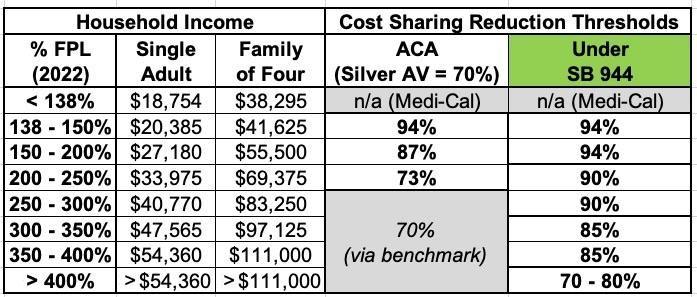BOOM: California officially announces state-enhanced CSR program to ELIMINATE deductibles for over 600,000 residents!

A few weeks ago I noted that, thanks to California Governor Gavin Newsom and the Democratically-controlled state legislature finally reaching a compromise agreement on how to allocate ~$330 million/year in revenue generated by the state's individual mandate penalty, around $83 million will be utilized to dramatically reduce out of pocket expenses for hundreds of thousands of ACA exchange enrollees.
Via Amy Lotven of Inside Health Policy:
California will direct a portion of money collected from the state’s coverage mandate to a reserve fund that will be used to lower out-of-pocket costs for Covered California enrollees under a budget deal that is receiving praise from wide-ranging health care stakeholders in the state. Advocates, providers and insurers also applaud a renewed tax on Medicaid managed care organizations that is expected to raise more than $19 billion that will be used to bolster Medi-Cal, including by increasing pay rates for certain providers, although the policy must be approved by the federal government.
...Under the agreement, $82.5 million will be allocated to the health care reserve fund in 2024, and $165 million will go into the reserve in 2025 and beyond.
That's roughly 25% which will go to the healthcare reserve fund this year; it sounds like the funds will be split 50/50 after that.
Here's what the original proposal from February 2022 looked like on the assumption that 100% of the revenue were to go towards reducing/eliminating cost sharing for ACA enrollees:
Under the compromise deal, the enhanced cost sharing reductions won't be available for those over the 250% FPL threshold...but they'll still be incredibly helpful for those below that income level.
Here's the official press release, via Covered California:
Covered California to Launch State-Enhanced Cost-Sharing Reduction Program in 2024 to Improve Health Care Affordability for Enrollees
SACRAMENTO, Calif. — California is set to continue its legacy of building upon and strengthening the Affordable Care Act, as its Board of Directors approved enhanced benefit designs that will ensure over 600,000 Covered California enrollees see reduced out-of-pocket costs in 2024.
“Covered California is proud to be a part of another visionary program that strengthens the Affordable Care Act,” said Jessica Altman, executive director of Covered California. “California made history with the State Premium Subsidy program in 2021, and we appreciate the continued leadership from Gov. Gavin Newsom and the state Legislature to make health care access and affordability a priority in our state.”
The new budget package passed by the state Legislature and enacted by Gov. Newsom appropriates $82.5 million of the Health Care Affordability Reserve Fund (HCARF) to Covered California to support a program of financial assistance for coverage year 2024. Per the budget agreement, funding for the program is planned to increase to $165 million starting in coverage year 2025.
Many Consumers Will Spend Less on Health Care Services
The Affordable Care Act requires health plans to reduce cost-sharing amounts and out-of-pocket maximums for consumers at or below 250 percent of the federal poverty level. Consumers can access these benefits by enrolling in cost-sharing reduction (CSR) plans built on Silver-level coverage.
The new state-enhanced cost-sharing program will strengthen these Silver CSR plans, increasing the value of Silver 73 plans to approximate the Gold level of coverage and increasing Silver 87 plans to approximate the Platinum level of coverage. Silver 94 plans already exceed Platinum-level coverage. About 40 percent of Covered California’s 1.6 million enrollees will be eligible for these cost-sharing reduction benefits.
Deductibles will be eliminated entirely in all three Silver CSR plans, removing a financial barrier to accessing health care and simplifying the process of shopping for a plan. Other benefits will vary by plan but will include a reduction in generic drug costs and copays for primary care, emergency care and specialist visits and a lowering of the maximum out-of-pocket cost.
Table 1: Comparison of Silver CSR Plans with State-Enhanced Cost-Sharing Reductions
I don't know how this translates into exact Actuarial Value increases, but it looks like it raises Silver 73 plans up to ~82% AV, Silver 87 plans up to ~92% AV and Silver 94 plans up to ~95%, or thereabouts.
But there's more as well:
To help ensure that the greatest number of people can take advantage of these cost savings and richer benefits, Covered California plans to automatically move about 35,000 enrollees from other metal tier plans into Silver CSR plans if they qualify and if doing so will provide more generous benefits at the same or lower monthly cost. Many more enrollees will be able to switch to a Silver CSR plan to take advantage of the new benefits.
This is something which CMS plans on starting to do next year as well, and it's a smart and helpful idea. I used to be leery about having the exchanges meddling in which policy enrollees choose, but as long as it's the same provider network/formulary and saves the enrollee money, I can't imagine too many people are gonna complain about it.
It's also worth noting that according to the official CMS 2023 ACA enrollment Public Use File, nearly 900,000 Californians who enrolled in ACA exchange plans this year earn between 138 - 250% FPL...but this press release suggests that only ~600,000 of those are currently enrolled in CSR plans (possibly only ~565,000...that 600K figure may not include the 35K they plan on upgrading). I'm not sure what the status is of the remaining 300K who appear to be eligible for CSR plans but who aren't enrolled in one yet.
In any event, they're making sure to let the enrollees know what's going on so they can opt out if they really have a beef with this:
Eligible consumers will be contacted by Covered California and will be able to make changes online, by calling the Covered California Service Center at (800) 300-1506, or through one of our 11,000 enrollment partners once the renewal period begins in October.
Reducing Barriers to Health Care
The new state-enhanced cost-sharing reduction program was designed to strengthen Covered California’s patient-centered benefit designs, which are crafted to help reduce financial barriers to health care.
A Kaiser Family Foundation survey in March of 2022 found that even among those Americans who have health insurance, just under half worry about affording their deductibles.
One-third of American adults stated that they or a family member have skipped a recommended medical treatment due to cost, while four out of 10 say they have delayed needed care.
“Recognizing that cost is still the key barrier to proper health care for too many Californians, our goal is to improve affordability for our enrollees in every aspect of their health care,” Altman said. “Combined with federal support for premiums under the Inflation Reduction Act, this will be the highest level of affordability support that has ever been available to our enrollees.”
Increased Benefits for Consumers Transitioning From Medi-Cal
With the end of the federal continuous Medicaid coverage requirement put in place to help Americans maintain coverage through the COVID-19 pandemic, in April, Medi-Cal resumed the renewal process for its more than 15 million members. The Department of Health Care Services (DHCS) estimates that between 2 and 3 million people will no longer be eligible for coverage.
The state-enhanced cost-sharing reduction program will assist many of these Californians because historically, more than 75 percent of individuals determined eligible for subsidies after losing Medi-Cal have been eligible for cost-sharing reduction plans.
While many Californians will transition to other forms of health insurance, such as coverage offered through their job or a family member’s employer, others will be eligible for coverage through Covered California, and they may receive financial help to lower the cost of their coverage. Covered California offers quality health plans, all of which provide many of the same benefits and services that Medi-Cal does, including free preventive care, doctor visits, prescriptions, hospital stays, behavioral health care and more.
Many people transitioning from Medi-Cal to Covered California will be eligible for quality coverage for little to no cost, including the increased benefits from the enhanced Silver CSR plans.





